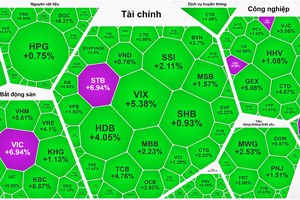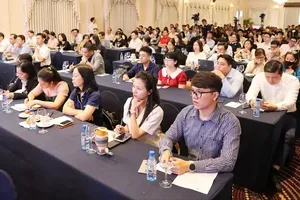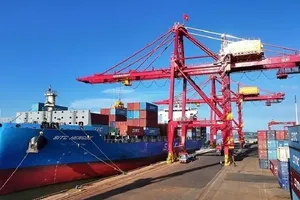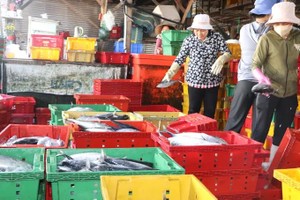 |
This difficult situation is forecast to last until the second quarter of this year, when some of these businesses hope that manufacturing will see more growth and orders later this year.
Severe struggle
In previous years, soon after the Lunar New Year holidays ended, textiles, garments, and footwear enterprises always accelerated their recruitment and training programs to complete customer orders in time. This year the situation where workers are concerned is very different. In a talk with Saigon Investment, Mr. Pham Xuan Hong, Chairman of the Ho Chi Minh City Textile and Apparel Association, said that workers this year have returned to work very early with about 90 percent of them returning to work in factories, but businesses are still facing a severe struggle in receiving orders.
According to Mr. Hong, the volumes of orders businesses have received so far is only 60 percent to 70 percent compared to the previous years, and some businesses have received absolutely no orders at all. Hence, in order to retain their existing trained employees, enterprises must arrange alternate working hours or reduce working hours so that every employee can have a monthly income. Mr. Hong said that for enterprises that use a lot of labor, their employees are valuable assets, so they are trying to retain their jobs until the market shows more positive signs.
Reduced working hours and rotating working hours is also taking place in many enterprises in the leather and footwear industry due to lack of orders. At a conference to review the tasks for the Lunar New Year, the Department of Labor, War Invalids, and Social Affairs in Ho Chi Minh City reported on the labor situation after Tet. The Pouyuen Vietnam Company, which specializes in manufacturing leather and footwear for exports with a large workforce of more than 50,000 people, has arranged for most of its employees to return back to work. However, enterprises still allocate the working time of employees as they did in the fourth quarter of last year, so that workers can work in rotation. Looking back at 2022, some leather and footwear businesses had to close down entirely due to all order being cancelled.
The latest statistics on the situation of labor and orders for enterprises across the country are rather worrisome. Accordingly, by the end of January, 528 enterprises saw their orders cancelled, mainly ones dealing in textiles, footwear, wood processing, and auxiliary industrial mechanics.
According to calculations of the textile and garment industry, leather and footwear orders decreased by 20 percent to 30 percent, wood processing by 70 percent, and ancillary industries by 50 percent. There are about 640,000 employees affected, mainly with reduced working hours. Statistics show that the number of normal working hours decreased from eight hours per day to more than seven hours per day.
Second quarter expectations
In the context of the current serious shortage of orders, the question that receives a lot of attention is when the situation will be bright again. Mr. Pham Xuan Hong said that the orders of enterprises will improve sooner or later depending on the situation in the Russia-Ukraine conflict, as well as the inflation in Vietnam's major importing countries, such as the US and the European Union countries.
However, businesses still expect things to get better soon from the second quarter onwards. Mr. Hong said that from the fourth quarter of last year by cutting down on non-essential items spending due to inflation concerns, it is hoped that from the second quarter onwards consumer demand in other countries will gradually recover and orders will also return to businesses in Vietnam.
The wood industry is also hoping that this year will be less difficult to deal with. At the year-end conference held in mid-January, Mr. Do Xuan Lap, Chairman of the Vietnam Timber and Forest Products Association, acknowledged that 2022 is being considered the most difficult year ever for the wood industry. Enterprises faced the challenge of lack of capital, lack of input materials, and a sharp decline in the product consumer market.
In the first quarter of 2023, the wood industry is still under a lot of pressure, but in the second quarter, it is expected that the number of basic orders will recover by 82 percent to 85 percent. The whole industry still sets a target of 7 percent to 9 percent growth, equivalent to a turnover of US$ 18 bln or more in 2023. According to an evaluation, after reducing the order quantity for a long time, wood products inventory in some major markets such as the US has begun to run out. In addition, in the first months of the year, there will be many large wood product fairs. This will be an opportunity for wood businesses to seek more orders for this year.
Many industries such as textiles are paying great attention to the problem of green production to be able to go a long distance and compete with other competitors because consumers of major importing countries are now placing very high-quality green production requirements on almost all products. In 2022, while many textile and garment producing countries experienced a decline in exports, Bangladesh was still growing at a steady pace. One of the reasons for Bangladesh to have stable exports is due to its strategy of maintaining green quality production within the garment industry. Currently, nine out of ten green garment factories in the world are located in Bangladesh.
Mr. Le Tien Truong, Chairman of the Board of Directors of Vietnam Textile and Garment Group, assessed that currently the advantages of Vietnam's textile and garment industry compared to other countries are not many, even if compared with Bangladesh in terms of technology access and green production, so we no longer have any advantage. Hence, if Vietnam wants to maintain the third position in garment exports in the world, it must accelerate pace in 2023, 2024, and 2025. This will not be easy. Although the Vietnamese textile and garment industry has implemented the green production program since 2018, almost 80 percent of small-medium enterprises have few resources for greening their production facilities.
























